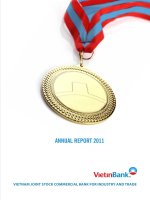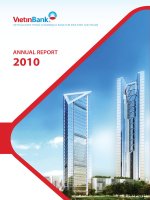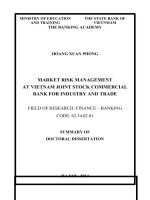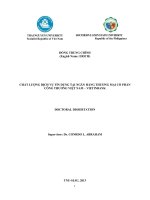International payment risk management in vietnam joint stock commercial bank for industry and trade hoang mai branch,graduation thesis
Bạn đang xem bản rút gọn của tài liệu. Xem và tải ngay bản đầy đủ của tài liệu tại đây (509.24 KB, 47 trang )
i
STATE BANK OF VIETNAM
BANKING ACADEMY
Foreign Language Faculty
-----o0o-----
GRADUATION THESIS
International payment risk management
in Vietnam Joint Stock Commercial Bank for Industry and Trade –
Hoang Mai Branch
Lecturer:
Tran Thi Hai Ly (MA)
Student’s name:
Hoang Phuong Thao
Student’s ID:
12A7511163
Class:
ATCB – K12
Hanoi, May 2013
ii
ACKNOWLEDGEMENTS
First of all, on the completion of the study, I would like to express my deepest
appreciation to my supervisor, Ms. Tran Thi Hai Ly of Foreign Language Faculty –
Banking Academy for her considerable help and great support during the process to
accomplish the study. I also thank her for her valuable suggestions, helpful advice and
careful comments on the research, which was of critical importance for this study.
Second, I am grateful to all trade finance’s staff of Vietinbank – Hoang Mai
Branch for the internship period, in which I received welcomed condition and had
opportunities to put all theory into practice.
I also owe a great debt of gratitude to all the lecturers of the Faculty of Foreign
Languages for the precious knowledge and studying encouragement throughout the
past four years at Banking Academy.
Last but not least, I would like to convey thanks to my family and friends for
their understanding and unconditional love during the time of conducting the thesis.
Hanoi, May 2013
Hoang Phuong Thao
iii
ABSTRACT
International payment is a characteristic and important off-table service in
business activities of Vietnamese commercial banks. Owing to the wide operating
scope and many parties related in international payment transactions, there are risks
which can occur at any time, affecting the parties badly. In this activity, commercial
banks are the intermediary providing payment services for customers. Besides
obtaining a specific amount of profit, they have to suffer particular risks which may be
loss due to the inability to receive money, unnecessary-fee payments and the
downgradation of banks’ reputation. Therefore, to dig deeper into this issue, the
research paper, “International payment risk management in Vietnam Joint Stock
Commercial Bank for Industry and Trade – Hoang Mai Branch”, aims at examining
the fundamental theory of risks in international payment; then exploring the real
situation of Vietinbank – Hoang Mai Branch based on the secondary data analysis.
Finally, after discussing some suggestions for the bank to manage common risks in
international payment, the thesis proposes several recommendations for the
Government and corresponding Ministries, the State Bank of Vietnam and Vietinbank
– Hoang Mai Branch so that risks can be controlled better.
iv
TABLE OF CONTENTS
ACKNOWLEDGEMENTS ........................................................................................ ii
ABSTRACT .............................................................................................................. iii
TABLE OF CONTENTS ........................................................................................... iv
LIST OF TABLES AND DIAGRAMS ...................................................................... vi
LIST OF ABBREVIATIONS ................................................................................... vii
INTRODUCTION ...................................................................................................... 1
1. Rationale of the study ............................................................................................. 1
2. Objectives of the study............................................................................................ 2
3. Research methodologies ......................................................................................... 2
4. Scope and focus ...................................................................................................... 3
5. Structure of the Thesis ............................................................................................ 3
CHAPTER 1: AN OVERVIEW ABOUT INTERNATIONAL PAYMENT AND
RISKS IN INTERNATIONAL PAYMENT ............................................................... 4
1.1.1 Notion of International Payment ........................................................................ 4
1.1.2 Terms and conditions applied to International Payment ..................................... 5
1.1.3 Common international payment methods ........................................................... 7
1.1.4 International Payment’s role............................................................................. 12
1.2 Risks in International Payment ............................................................................ 13
1.2.1 Notion of risk and risk in international payments ............................................. 13
1.2.2 Types of risks in International Payment ........................................................... 14
CHAPTER 2: REAL SITUATION OF INTERNATIONAL PAYMENT ACTIVITY
AND RISKS IN INTERNATIONAL PAYMENT IN VIETINBANK – HOANG MAI
BRANCH ................................................................................................................. 18
2.1 An overview about Vietinbank – Hoang Mai Branch .......................................... 18
2.1.1 The formation and development history of Vietinbank – Hoang Mai Branch ... 18
2.1.2 Business activities of Vietinbank – Hoang Mai Branch from 2010 to 2012 ...... 19
2.2 Real situation of international payment activities from 2010 to 2012 .................. 23
v
2.2.1 Turnover of international payment ................................................................... 23
2.2.2 Proportion of International Payment’s methods ................................................ 25
2.3 Risks of International Payment in Vietinbank – Hoang Mai Branch .................... 26
2.3.1 Political risk and legal risk ............................................................................... 26
2.3.2 Foreign exchange risk ...................................................................................... 27
2.3.3 Moral risk ........................................................................................................ 28
2.3.4 Credit risk ........................................................................................................ 29
2.3.5 Operational risk................................................................................................ 30
CHAPTER
3:
SOLUTIONS
AND
RECOMMENTDATIONS
FOR
INTERNATIONAL PAYMENT’S RISKS MANAGEMENT IN VIETINBANK –
HOANG MAI BRANCH .......................................................................................... 32
3.1 Solutions for International Payment’s risks management in Vietinbank – Hoang
Mai Branch ............................................................................................................... 32
3.1.1 Political and legal risk management ................................................................. 32
3.1.2 Foreign exchange risk management ................................................................. 32
3.1.3 Moral risk management .................................................................................... 33
3.1.4 Credit risk management ................................................................................... 33
3.1.5 Operational risk management ........................................................................... 34
3.2 Recommendations for International Payment’s risks management in Vietinbank –
Hoang Mai Branch .................................................................................................... 35
3.2.1 Recommendations for Government and correspondent Ministries .................... 35
3.2.2 Recommendations for the SBV ........................................................................ 36
3.2.3 Recommendations for Vietinbank – Hoang Mai Branch ................................... 37
CONCLUSION ........................................................................................................ 38
REFERENCES ......................................................................................................... 40
vi
LIST OF TABLES AND DIAGRAMS
Number
Name
Page
Table 2.1
Total capital mobilized from 2010 to 2012
19
Table 2.2
Lending activities of Vietinbank Hoang Mai
21
from 2010 to 2012
Diagram 1.1
The process of remittance method
8
Diagram 1.2
The process of collection method
9
Diagram 1.3
The process of documentary credit method
11
Diagram 2.1
The structure of Capital mobilization of
20
Vietinbank – Hoang Mai Branch in 2012
Diagram 2.2
Non-paid loan rate of Vietinbank – Hoang
22
Mai Branch from 2010 to 2012
Diagram 2.3
Turnover of international payment activities of
24
Vietinbank – Hoang Mai Branch from 2010 to
2012
Diagram 2.4
Proportion of international payment’s methods
of Vietinbank – Hoang Mai Branch in 2012
25
vii
LIST OF ABBREVIATIONS
Number
Abbreviations
Original
1
HO
Head Office
2
L/C
Letter of Credit
3
SBV
State Bank of Vietnam
4
SMEs
Small and Medium Enterprises
5
SWIFT
Society
for
Worldwide
Interbank
Financial Telecommunication
6
UCP
Uniform Customs and Practice for
Documentary Credits
7
USD
United State Dollar
8
Vietinbank
Vietnam Joint Stock Commercial Bank
for Industry and Trade
9
VND
Vietnam Dong
1
INTRODUCTION
1. Rationale of the study
International integration has brought many chances to Vietnam in economic
development since the country became a member of World Trade Organization
(WTO) in 2006. Foreign trade activities have also been widened recently, which leads
to higher need for Vietnam to corporate with other countries. The role of commercial
banks, especially in international payment field, therefore, has been paid more
attention to.
It has been shown in statistics that among external economic activities of
Vietnamese commercial banks, international payment takes up a large proportion to
raise banks’ turnover by fees collected from related doings. Realizing its meaning,
commercial banks have recently invested more in renovating international payment
system. For example, training staff specializing in this field, upgrading technology and
organizing payment set-up suitable with international standards have been focused. As
a result, international payment services in banks have gained encouraging outcomes.
With the strength of being one of the biggest Vietnamese commercial banks,
building wide business networks, supplying a variety of high-quality banking services,
having good reputation and being a member of Society for Worldwide Interbank
Financial Telecommunication (SWIFT), Vietnam Joint Stock Commercial Bank for
Industry and Trade satisfies customers’ demands about international payment services.
Moreover, its modern technology is often updated and applied to the payment system
to save time and expenses, as well as increase revenue from business activities.
However, continual changes of the international and domestic economy, together with
the issuance and correction of regulations and laws challenge the bank to improve its
payment process and ensure the efficiency of international payment operations. Many
other risks can also be seen during practice, resulting in the revenue and fame
reduction. Consequently, it is really important for the bank to be aware of risks so as to
2
avoid them while working. If risk management is handled well, banking services will
develop more effectively.
From this fact, after an internship period in Vietnam Joint Stock Commercial
Bank for Industry and Trade – Hoang Mai Branch, the topic “International payment
risk management in Vietnam Joint Stock Commercial Bank for Industry and Trade –
Hoang Mai Branch” has been chosen with the aim of providing related parties with
deeper understanding and practical solutions and recommendations to enhance
international payment business of the bank.
2. Objectives of the study
The study is conducted to provide an overview of international payment and its
risks in commercial banks, analyze and assess common risks, as well as propose
solutions and recommendations to prevent them in international payment process in
Vietnam Joint Stock Commercial Bank for Industry and Trade – Hoang Mai Branch.
3. Research methodologies
After my internship period in Vietinbank – Hoang Mai Branch, I have collected
important primary through personal interview and observation and secondary
information from annual reports of the bank for my research. Methods of data
comparison, analysis and synthesis are used to clarify the content of the research issue.
Three main questions are interviewed in the writing. They are:
1) What are common risks in international payment Vietinbank – Hoang Mai
Branch has to face?
2) Why do risks happen?
3) What does Vietinbank – Hoang Mai Branch do to avoid risks?
3
4. Scope and focus
The study focuses on international payment risk management of Vietnam Joint
Stock Commercial Bank for Industry and Trade – Hoang Mai Branch, supported by
research data calculated in the last three years from 2010 to 31 December, 2012.
5. Structure of the Thesis
Beside the Introduction and Conclusion parts, the thesis is divided into three
chapters as below.
Chapter 1: An overview about International Payment and risks in International
Payment.
Chapter 2: Real situation of International Payment activities and risks in
International Payment in Vietinbank – Hoang Mai Branch.
Chapter 3: Solutions and recommendations for International Payment’s risks
management in Vietinbank – Hoang Mai Branch.
4
CHAPTER 1: AN OVERVIEW ABOUT INTERNATIONAL PAYMENT AND
RISKS IN INTERNATIONAL PAYMENT
1.1 An overview about International Payment
To understand what international payment is, people initially comprehend the
notion which is a generally picture about international payment activities.
1.1.1 Notion of International Payment
The relation among countries is based on many factors, such as economic,
politic, diplomatic and cultural relation, in which the economic one plays an important
role to ensure the existence and development of other international relations.
Globalization brought about nations’ demand in payment and transaction. However,
the geographic distance was an obstacle, which requires a go-between agent to support
and ensure settlement. Therefore, international payment was formed with banks’
position as an intermediary to connect parties. According to the author of the book
“International Payments and Commercial Finance”, Doc. Nguyen Van Tien,
“International payment is a process executing obligations to payment and entitlements
to benefits of money which leads to economic and non-economic activities between
organizations, individuals of different nationalities or between a nation and an
international organization through banks of related partners”.
Economically, international payment is divided into two types: trade payment
and non-trade payment. The former means that making payment depends on
commercial goods and services exchange following worldwide price. In this kind, the
bound between the seller and the buyer is sale contract which shows the particular
relation and regulates specified payment conditions. In contrast, the latter doesn’t
involve goods for exporting and importing as well as labor supply services. In other
words, it is to make payment for non-commercial activities. Non-trade payment is the
payment for expenses of diplomatic missions in foreign countries, travel and
accommodation expenses of state delegations, organizations and individuals, etc.
5
Because international payment is an activity relating to many parties and seems
to be complicated, certain terms and conditions must be used to regulate this business.
1.1.2 Terms and conditions applied to International Payment
There are four terms and conditions which are relevant to international
payment: Currency, payment place, payment time and payment instruments and
methods.
1.1.2.1 Currency terms and conditions
Payment for goods and services in international commerce usually engages to
the currencies of more than one country, so the decision of which currency to use can
become a considerable impediment to conduct a transaction. Therefore, the right
selection in currency terms and conditions is one of the decisive factors to business
efficiency in external activities.
In current foreign trade practices, currency choice is made depending mainly on
the habit of using currency in commerce and international payment. For example, in
terms of goods such as rubber, tin and some ferrous metals, the pound sterling (GBP)
is chosen as payment currency. Meanwhile, to the others, the currency used is the US
dollar (USD). Despite being an important factor, it is not very difficult for parties to
decide which payment currency because foreign exchange market now develops so
well that there is no significant obstacle in changing from one currency to another.
However, in most cases, the particular currency of a deal will be a “hard currency”
such as the US dollar (USD), the European euro (EUR), the Swiss franc (CHF) or the
Japanese yen (JPY).
1.1.2.2. Terms and conditions of payment place
Payment place is where the seller receives payment and the buyer pays. It is a
common sense that the seller always wants to obtain money in his own country
because of faster and safer collection. Meanwhile, the buyer would like to make
payment in his nation to avoid capital backlog. Theoretically, the payment can be
made in the third country which issues settlement currency. Nevertheless, in fact, the
6
decision of payment place relies principally on the power relationship between the
seller and the buyer in sale contract, payment methods and the currency in payment.
1.1.2.3 Terms and conditions of payment time
Terms and conditions of payment time are compulsory in international payment
transactions. The determination of payment time is the foremost concern of parties
because it is associated with financial market’s fluctuation from sale contract signed to
the due date of payment. The payment period contains risks of the market’s instability
from which parties have to suffer, so there should be negotiations to decide it.
There are three types of payment time, which are advance, at sight and deferred
payment.
To specify, advance payment or prepayment means that part or total amount of
the contractual sum due for goods or services is paid in advance prior to delivery date.
The nature of advance payment is the buyer provides a credit to the seller, so the buyer
may face risks when the seller is not reliable or reputable.
At sight payment, secondly, indicates that the buyer pays at sight when
receiving seller’s notice or shipmaster’s announcement that goods are ready at
dispatch port. It also means that payment is made at sight on receipt of documents
presented by seller or goods at discharge port.
The third one is deferred or time payment, which is an agreement that the buyer
have to pay after a number of days since receiving contractual goods, getting notice of
the seller completing his obligation to deliver contractual goods or bill of lading date,
etc. This type of payment is a form of trade credit the seller offer for the buyer.
1.1.2.4 Terms and conditions of payment instruments and methods
In international payment, the choice of payment instruments and methods is the
conformity of parties. Paying tools which can be used are cash, cheque, bill of
exchange, promissory note and payment card.
Payment method in international commerce is the whole process and
regulations for the buyer to pay and receive goods and the seller to do shipment and
obtain money according to sale contract through banking system. There are common
7
ways in international payment, which are advanced payment, open account,
remittance, collection of payment and documentary credit.
1.1.3 Common international payment methods
The study will concentrate on three common methods of international payment,
which are remittance, collection and documentary credit.
1.1.3.1 Remittance
Remittance is a payment method in which the customer or remitter requests his
bank to transfer a specified amount of money to the beneficiary of a defined address in
a particular period of time. In remittance, there four parties involved: the remitter, the
beneficiary, the remitting bank and the paying bank.
The remitter remits the money to the beneficiary as it is required by the contract
concluded between them. When the remitter comes to the remitting bank, he fills in an
application form for the bank to effect the payment. The paying bank pays the
beneficiary because it is the branch bank or correspondent bank of the remitting bank
in the seller’s country. The banks do not have any responsibility to the remitter and the
beneficiary.
It is clear that in the method of remittance, making payment depends on the
buyer’s willingness. After receiving goods, the buyer can refuse payment or extend
time payment intentionally, so the seller’s benefit is not ensured. Owing to this
disadvantage, remittance is often applied in international commerce when the parties’
reputation and mutual trust is high.
According to the textbook, International Payment and Commercial Finance, by
Nguyen Van Tien, there are two types of remittance. The first one is mail transfer
(M/T) in which Bank draft of the remitting bank is sent by mail to the paying bank. In
the other type named telegraphic transfer (T/T), bank draft of the remitting bank is
shown under the content of a telegram, transferred to the paying bank through telex or
swift. Of two types, mail transfer is low-cost but time-consuming, while telegraphic
transfer is more expensive but much faster.
Specifically, the process of this method is shown in the diagram below:
8
Remitting Bank
Paying Bank
(3)
(2)
(4)
(1)
Remitter
Beneficiary
Diagram 1.1: The process of remittance method
Diagram 1.1 provides steps in remittance method.
(1) Commercial transaction includes signing sale contract or supplying goods
and services.
(2) Remitter or importer asks remitting bank to deliver a certain amount of
money to beneficiary or exporter.
(3) Remitting bank asks its agent bank in foreign country to deliver the money
to beneficiary.
(4) Paying bank pays for beneficiary.
1.1.3.2 Collection
Under collection, the exporter or the seller takes the initiative to collect
payment from the importer or the buyer. Upon the delivery of the goods, the exporter
draws a bill of exchange on the importer for the sum due, with or without shipping
relevant documents attached, and authorizes his bank to effect the collection of the
payment through its branch bank or correspondent bank in the importer’s country.
Collection can be of either documentary collection or clean collection.
Documentary collection which is most often operated in the payment of goods in
international trade has the relevant shipping documents attached to the draft, while in
clean collection that is occasionally exercised, only draft is used.
9
A documentary collection is a command by the seller to his bank to collect
payment from the buyer in exchange for the transmission of documents that enable the
holder to take control of the goods. Under a documentary collection, the seller ships
goods to the buyer but sends shipping documents to the forwarding bank for
transmission to the buyer’s bank. The buyer’s bank is ordered not to transfer the
documents to the buyer until payment is made (Documents against payment, D/P) or
upon promise that payment will be made within a particular period of time
(Documents against acceptance, D/A). Once in possession of the documentation, the
buyer may take ownership of the shipment.
Documentary collections concentrate on the transfer of title documents that
authorizes its holder to take possession of the shipment to goods rather than on
immediate transfer of goods themselves. In this method, banks being relevant to the
transaction do not assure payment but function only as collectors of payment.
Collection method follows these steps presented in the following diagram:
(3)
Remitting Bank
Collecting Bank
(6)
(2)
(7)
(5)
(4)
(1)
Exporter
Importer
Sale contract
Diagram 1.2: The process of collection method
(1) Exporter delivers goods and creates documents which are sent straight to
importer in case of clean collection or are sent with bill of exchange (B/E) to
the bank in case of documentary collection.
10
(2) Exporter draws B/E and asks remitting bank to collect money from importer
(clean collection) or exporter sends documents with B/E to the bank and
asks the banks to collect the amount of money given in B/E.
(3) , (4) The banks helps exporter to claim money.
(5), (6), (7) Importer pays money for exporter through banks.
1.1.3.3 Documentary Credit
On the word of A Short Course in International Payments 2nd edition by
Edward G. Hinkelman, a documentary letter of credit or documentary credit is a
bank’s commitment to pay the seller a specified amount of money on behalf of the
buyer so long as the seller complies with precisely defined terms and conditions
specified in the credit (L/C). Because the L/C solves the possible problems arising
from the distrust between the seller and the buyer, this method provides almost equal
security to both the buyer and the seller.
When a letter of credit is issued by the buyer’s bank, the bank takes on the
payment responsibility for the buyer. With use of a letter of credit, the buyer and the
seller do not communicate directly. The bank acts as an intermediary between the two.
The bank, however, deals only with the documents regarding the goods rather than the
goods themselves.
Documentary credit is the most common form of international payment because
it offers a high degree of protection for both the buyer and the seller. The buyer
itemizes documentation required from the seller before the bank is to make payment,
and the seller is given assurance that payment will be made after shipping the goods on
condition that the documentation is in order. The key document is bill of lading or title
document. However, if the buyer and the seller have a subsequent disagreement
regarding the order, it is carried out between them independently of the bank or of
payment.
Consistency and accuracy are dominant in preparing and submitting documents
for payment under a letter of credit. The documents presented for payment by a seller
11
must match correctly with the wordings specified in the letter of credit or the bank will
not make payment. Many documents presented under letters of credit carry some sorts
of error (small or large) that can reschedule or prevent the fulfillment of the credit.
The following diagram illustrates the process of documentary credit method:
(2)
Advising Bank
Issuing Bank
(5)
(6)
(3)
(5)
(6)
Exporter
(8)
(4)
(7)
(1)
Importer
Diagram 1.3: The process of documentary credit method
(1) Importer sends issuing bank an application to open L/C for beneficiary.
(2) Based on the application, issuing bank issues L/C, informs its contents to
exporter and gives the original L/C to him through his bank.
(3) Advising bank delivers L/C to exporter.
(4) Exporter sends goods to importer if L/C is accepted, in the case that L/C is not
agreed, exporter asks importer and issuing bank to correct L/C. Goods are not
delivered until L/C is suitable.
(5) Exporter creates a set of documents and presents to issuing bank through
advising bank to claim payment.
(6) Issuing banks checks the documents. If they are complying with L/C, issuing
bank pays for exporter. If not, the bank can refuse payment and return all
documents to exporter.
(7) Issuing bank asks importer to pay.
12
(8) Importer checks documents. If they are complying, importer pays for issuing
bank. If not, importer can refuse to make payment.
1.1.4 International Payment’s role
1.1.4.1 International Payment’s role in the economy
With the world’s economy tendency to be internationalized, many countries
have been making efforts to develop the open-door market, cooperation and
integration. Especially, the external economic relation is now claimed to be the key in
the nation’s development strategies. In that situation, the vital role of international
payment activities has been confirmed in the national economy generally and the
external one specifically.
International payment, firstly, is a crucial factor in the process of goods and
services exchange between organizations and individuals of different countries. If
there is no international payment activity, it will be hard for external economy to exist
and grow. The expansion of international payment also harmonizes the relation
between the buyer and the seller, the payer and the payee, or the related parties who
have differences in geographic location, currency and business habit, etc.
The function of promoting export and import activity is another essential part of
international payment to the economy. Regulations and conditions in how to make
payment are closely related to rights, responsibilities and duties of parties in sale
contract. Furthermore, risks can be prevented by solutions performed timely. For that
reason, it can be said that the efficiency in export and import business is largely
influenced by the quality of payment process, pushing external economy to be
improved.
It is claimed that international payment is a direct feature having an effect on
business competence. Through payment process, financial capacity, reputation and
potential of organizations or individuals can be assessed. Also, it can be based on the
review of payment activities to find counterparts or partners in business relation so that
each party’s rights are protected maximally. Therefore, international payment operated
well will give favorable conditions to promote export and import, enhance domestic
13
manufacture, improve goods’ quality and fulfill the countries’ target of managing
exporting market.
1.1.4.2 International payment’s role in commercial banks
Beside the important role to the whole economy, international payment which
brings significant revenues is also an essential service to commercial banks. It is
imperative for banks to take improvement and development strategies into
consideration.
International payment is of great essence in linking and boosting other banking
business activities such as foreign exchange trading, financing export and import,
increasing capital mobilized especially foreign currency capital. It is the fact that
commercial banks now run multi-functionally, forming a closed chain of trading in
which each business is an indispensable part. International payment is considered a
basic one to build up others. In addition, by supplying international payment services
to customers, banks can obtain fee and acquire specific profit. It depends on payment
methods, competitive environment and customers’ credibility to apply different levels
of fees which generate turnover and benefit of commercial banks. Thus, it is
comprehensible why commercial banks have focused on international payment’s
expansion.
Furthermore, in terms of national management, the government can
conveniently administer foreign currency in and out of the country based on balance of
payments (BoP). The building and implementation of fiscal and monetary policy also
become easier.
With its importance in the whole system of economy and commercial banks,
international payment has been more concentrated on to produce higher return in
banking activities. Despite this, it cannot avoid potential risks, which is one of
concerns of parties in international payment.
1.2
Risks in International Payment
1.2.1 Notion of risk and risk in international payments
14
Risk is defined differently in various areas by many people or sources. It is a
general notion extracted from Wikipedia that “Risk is the potential that a chosen action
or activity (including the choice of inaction) will lead to a loss (an undesirable
outcome)”. From this notion, people can understand simply that any choice has an
influence on the outcome and potential losses themselves are called “risk”.
Risk in international payment is the risk arising in the working process of
international payment, involving international transactions. Its causes are related to
the relation among parties in international payment such as importers, exporters,
banks, organizations, individuals or objective factors like natural disasters, wars or
politics, etc.
Unlike internal transaction, the accomplishment of external one has difficulties
in geographic distance, discrepancies in culture, laws, etc. that hinder international
payment activities and trigger severe effects.
1.2.2 Types of risks in International Payment
Despite developing in both quality and proportion, international payment
services of commercial banks cannot avoid risks during operating process.
1.2.1.1Political risk
The political situation in both the exporting and importing country can have
catastrophic effects on international business transactions. Political volatility can
produce alterations in trade policy, constraints on foreign transfers and restrictions on
exportation or importation of particular goods. It can also set off changes in monetary
policy causing devaluation of the local currency, and riots or civil restlessness which
may lead to loss or damage to commodities potentially not covered by insurance. In
spite of being generally outside the direct management of either trader, political risks
can be forecast in the short term and handled to a certain degree.
There are main reasons resulting in political risk in international payment,
which are causes inducing political, social, ands economic instability of a country. It
can be conflicts in ethnicity, political parties and religion or social struggle through
riots, demonstrations and wars. The problem of accumulating foreign loans, low level
15
of foreign exchange reserves and the deficit of BoP force the country of importer to
prohibit making payment or the exchange of foreign currency. The sanctions of the
international payment to the importing country can also put its global commerce and
NOSTRO accounts under strict control, even blockade, so banks cannot make payment
for other countries. Besides, the foreign exchange management policy is suddenly
adjusted, being the occasion of risks for parties in international payment activities.
1.2.2.2 Legal risk
The type of legal risk happens in case of disputes or complaints from parties in
international payment. At that time, the problem is that the court of which country will
be responsible for conducting these cases and they will be dealt with by which
country’s legal basis. Although they are mentioned in sale contract, it is still complex
to manage because of the deficient knowledge about laws in the other party’s country.
The root cause of legal risk is the parties’ dissimilarity of legal environment and
laws. Moreover, lack of comprehensive information of legal issues can precipitate
unimaginable difficulties in local marketplace. Even though UCP 600 is a legal
framework governing international payment transaction, it is applied differently and
driven by systems of laws and regulations in each country. These may include
unidentified practical limitations, import regulations and other problems. For example,
a contract signed in a foreign country was ruled invalid because the trader was
unacceptably in the country on a tourist visa. Therefore, it is far from easy to avoid
legal risk which can only be managed through extreme diligence.
1.2.2.3 Foreign exchange risk
Foreign exchange risk occurs when a specified foreign currency is set as
payment one. If exchange rate is volatile, there will be disadvantages for parties in
international payment. Specifically, the importer will suffer loss when the foreign
currency chosen as payment currency appreciates. In contrast, the risk will belong to
the exporter if it devalues. In documentary credit transactions, banks can bear foreign
exchange risk.
16
The unstable exchange rate is impacted by two terms. The first one is outside
factors which are economic situation, international financial market and the country’s
policy. Secondly, that is the multidimensional interaction of each nation’s economic –
financial – monetary rule. In other words, it is the relationship between supply and
demand in the marketplace affecting the exchange rate.
1.2.2.4 Moral risk
Morality can be understood as business credibility or reputation. Moral risk
takes place when a party has intention of not doing their duties, affecting others’
advantages. This is an important issue in international payment because of the far
distance between parties who even cannot meet each other in person during doing
business.
The problem of asymmetric information is the underlying reason of moral
hazard. It is also due to the lack of precise knowledge about the counterpart’s financial
capacity, business activity situation and reputation or trustworthiness. As a result,
inaccurate decisions are made, creating risks in making payment. Especially, to
documentary credit, according to UCP 600, making payment is totally based on
documents not good. Some organizations or individuals can take advantage of this
limitation to cheat, which is the moral risk in international commerce.
1.2.2.5 Credit risk
Credit risk is the risk often seen in international payment when one of the
parties cannot afford to make payment.
There are two main reasons leading to credit risk. In the market economy,
corporations and banks run in an intense competitive environment, influenced by
competition or supply and demand rules, so they must often face the risk. It may be
because of price instability, outdated technology, weak managing and operating ability
or financial crisis, etc. that series of companies have difficulties in business activities,
even have to declare bankruptcy. Furthermore, by reason of deficient credit
information that a party does not update current financial status, check the efficiency
17
of projects and relations with customers of the other, credit risk becomes more
complicated to be controlled.
1.2.2.6 Operational risk
Operational risk is technique errors brought about by the parties in international
payment. It is shown in not complying presentation which does not follow regulations
and terms of L/C or other legal framework.
This kind of risk is often seen in documentary credit whose characteristic is that
banks only perform payment transactions on the surface of documents. Therefore, this
method requires exactly complying presentation between payment documents and L/C.
Any mistake found by the buyer or issuing banks can result in payment turned down.
In case of the bank negotiating documents without finding inaccuracy or ignoring the
small one, it will suffer every risk if the issuing bank refuses payment. Especially,
when the negotiating bank is also the confirming bank, it will not have rights in the
recourse of negotiated amount of money from the exporter or the seller. The risk can
also belong to the issuing bank in checking documents to open L/C. For instance,
when irrevocable L/C is issued, the bank cannot freely cancel or modify it but is
allowed to inform the inaccuracy within five working days since receiving documents.
If exceeding the permitted time, the bank will have to accept all the risks. To the
advising bank, it is responsible for confirming the authenticity of L/C to avoid risk for
it and the exporter.
Operational risk occurs mainly due to the low level of knowledge about
international payment of parties. They do not understand deeply strict conditions of
L/C and UCP, making mistake during transaction time from composing and signing
sale contract to creating documents and paying. In addition, professional skills and the
aware of making payment of parties can raise operational risk.
18
CHAPTER 2: REAL SITUATION OF INTERNATIONAL PAYMENT
ACTIVITY AND RISKS IN INTERNATIONAL PAYMENT IN VIETINBANK
– HOANG MAI BRANCH
2.1 An overview about Vietinbank – Hoang Mai Branch
Before exploring the real situation of international payment and its risks in
Vietinbank – Hoang Mai Branch, the study supplies a general picture about the bank’s
history and current business activities from 2010 to 2012.
2.1.1 The formation and development history of Vietinbank – Hoang Mai Branch
Vietnam Joint Stock Commercial Bank for Industry and Trade (Vietinbank)
was founded in 1988 after the separation from the State Bank of Vietnam (SBV). For
the purpose of expanding business network and meeting the customers’ demand,
Vietinbank - Hoang Mai Branch was established under the decision No. 269 HĐQT –
NHCT1 on 6th November 2006. Officially being put into operation on 20th January
2007, experiencing a business period, Vietinbank Hoang Mai has kept setting up,
strengthening and perfecting the organizing structure, technical equipments and
varying business activities. As the decision No.158/QĐ- HĐQT – NHCT1 on 14th June
2004 of Vietinbank’s Chairman of the Board, it is upgraded from the second to the
first class branch of Vietinbank.
The workforce which is rather young, enthusiastic and has been trained is the
strength of Vietinbank – Hoang Mai Branch. The total number of bankers reached 295
people at the end of 2007 and continued to increase in the following years. In addition,
the staff training is always considered the primary task with the strategy of developing
human resources according to the international standards and professional recruitment
process.
Besides, Vietinbank Hoang Mai also focuses on expanding its business
association. After over three operating years, in 2010, the branch had three transaction
offices of type one, five transaction ones of type two, three savings funds spreading in
Hoang Mai, Hoan Kiem, Dong Da and Thanh Tri District in Hanoi. On 20 th December









